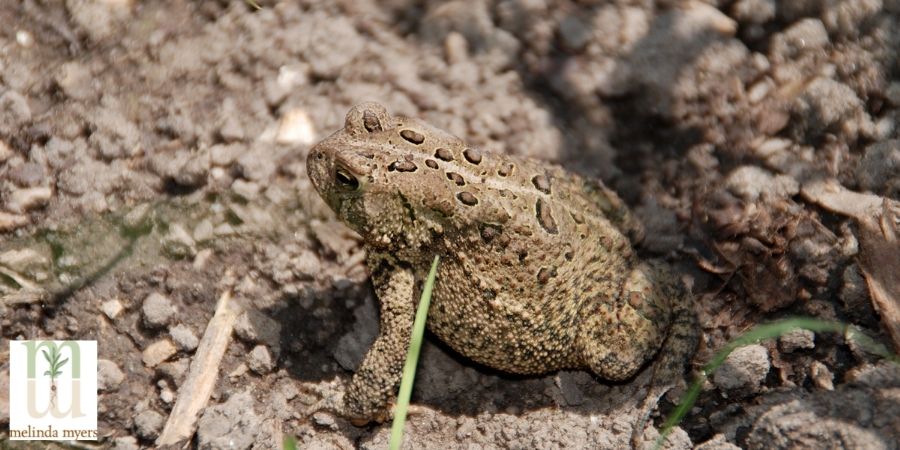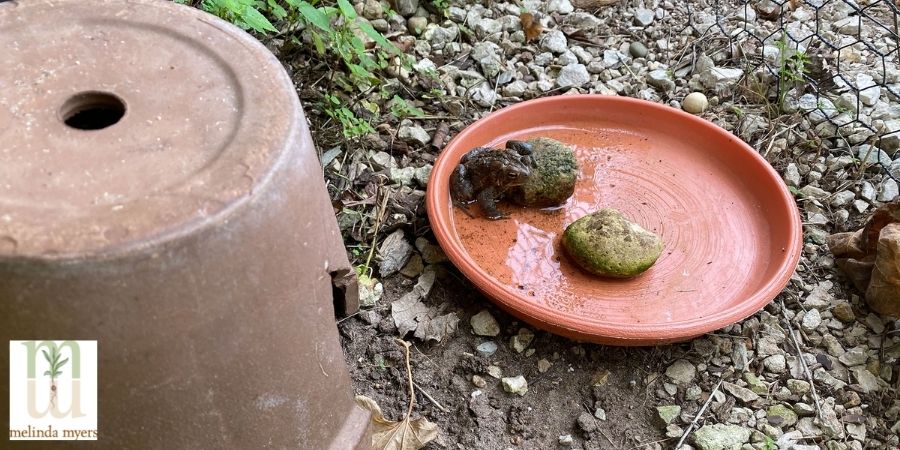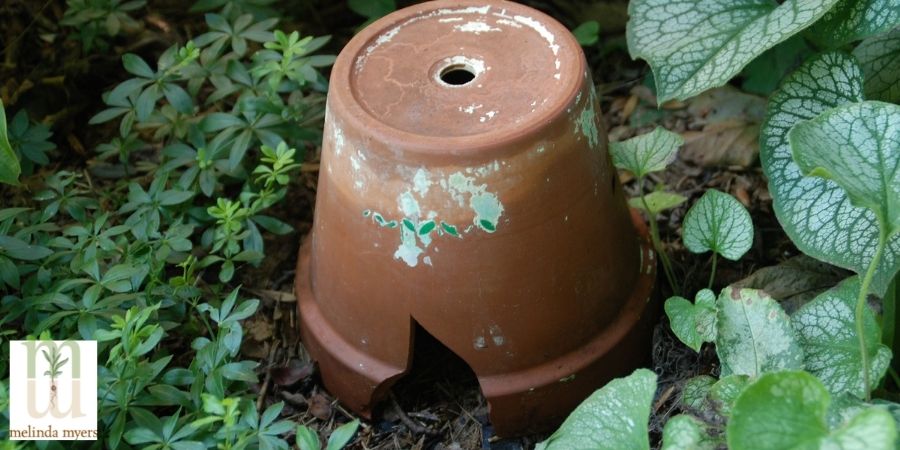Attracting Toads and Frogs to Your Landscape
- horticulturist and gardening expertJuly 10, 2021
Toads and frogs make great gardening partners. They eat lots of insects, including mosquitoes, slugs, and snails, and ask for very little in return. Help attract these natural predators to your garden with just a few changes in your gardening habits.
I am lucky to have toads, frogs, and even salamanders living in my gardens. They often surprise me when watering pots of plants, weeding, or just tending my gardens. I am always looking for ways to adapt my garden designs and maintenance to improve their living conditions. After all, they are truly gardeners’ friends with each adult toad eating up to 10,000 bugs in one summer.
Difference between Toads and Frogs
Let’s start with a closer look at these amphibians. Frogs tend to have longer back legs allowing them to jump high and long. Their smooth skin is covered with mucus making them look slimy. Frogs’ bodies are rather narrow and eyes tend to be round and bulge. They need to live near water and have lots of predators.

A toad in the garden
Toads on the other hand have short less powerful legs so they tend to run or take much shorter hops than frogs. Their skin is dry, rough or bumpy, and thick. It releases a bitter taste and smell that discourages predators from eating them. You’ll notice toads have wider bodies and lower more football-shaped eyes.
The differences are not always this pronounced. Some frogs have warts and some toads have slimy smooth skin. This has lead to a debate between biologists trying to properly classify these amphibians. But neither will give you warts and both are welcome guests in the garden.
First Step- Skip the Pesticides
Whether bumpy or smooth both frogs and toads have thin permeable skin. This allows them to absorb oxygen and release carbon dioxide through their skin. Adult toads and frogs also have lungs for breathing.
Their thin permeable skin allows toxins and pollutants to pass through and enter their bodies. These chemicals can disrupt development, reproduction and even kill these creatures. This is why they are considered an indicator of environmental health. So skip the pesticides to help keep them safe and enlist other strategies when needed to manage weeds, diseases, and insect pests in the garden. And if you already have frogs and toads in your yard you may only need to make a few minor changes to attract even more.
Create An Inviting Habitat
Relax your garden cleanup routine. A tidy garden is not where toads and frogs prefer to live. Leave some leaf litter under trees and shrubs and in the garden. This natural mulch provides a cool damp environment perfect for them. It also helps conserve moisture, suppresses weeds, and improves the soil as the leaves decompose. All this is good for the health of your plants and means less maintenance for you.
Create dense plantings of native perennials and grasses that provide shady hideouts and great hunting grounds for these amphibians. They will find insects, worms, slugs, snails, and more to dine upon in these lush locations. Include some night-blooming fragrant plants to help attract night-flying moths. You’ll provide food for the toads and frogs’ night hunts and fragrances for you to enjoy.
Rotting logs, rock piles, and non-mortared stonewalls provide shelter for toads, immature and female frogs often hibernate in these habitats as well.
Build a rock pile in the garden. Select a location that receives sun and shade each day. Position the rock pile in more sun if your summers are cool and more shade if your summers are hot. Line the bottom with stones for added protection from winter cold and leave spaces between the stones on the bottom layer. These cavities are used for nesting, shelter, and hibernation. Use a pipe 1 to 2 inches in diameter and less than 2 feet to create an entryway.
Provide access to water and wet sites for egg-laying and homes for many adult frogs. Even a shallow saucer filled with chlorine-free water provides toads with needed water.

A toad enjoying a saucer filled with water
Adding a shallow pond can help boost your landscape’s frog appeal. A small pond 4’ by 6’ and 20” deep makes an adequate home for most frogs. Place your pond where it receives some sunlight and a bit of shade in areas with extremely hot summers. You can dig the pond yourself and install a liner to keep the water in place. Create sloping sides to allow the frogs easy access in and out.
Pre-formed hard plastic pond liners are another option. Just pile some rocks inside along the edge to form a ramp so the frogs have easy access into and out of the pond.
Place rocks and logs in the pond for basking in the sun and some around the outside edge of the pond, for shade and protection from predators. Native plantings in and around the pond also provide cover from predators and the weather, oxygenate the water and help attract insects to keep your frogs well fed.
Fill your pond with rainwater or chemical-free water. No need to aerate the pond as frogs prefer still water and will enjoy dining on any mosquito larvae developing in the water.
Build a Toad Abode
Expand the housing options by creating toad abodes. This is a fun project for gardeners of all ages
Place your toad abode in a shady spot in the dampest place in your yard. Setting it under a shrub, near a downspout or space where the air condition drips work well. Add a bit of compost into the soil where the toad house will be placed to create the perfect floor for your toad house.
You can buy a toad abode or making your own is very easy. Just place a clay pot upside down on the soil. Elevate one side with a rock or two to create a doorway. Repurpose a damaged clay pot with a portion near the top missing. Just set it upside down on the soil and the missing portion provides the entryway. No need to add any flooring. Toads like to dig so a dirt floor is perfect.

A toad abode
Create a toad cave by setting the pot on its side. Bury the bottom half with soil leaving the top half open.
Place a saucer with water near the toad abode. Now your toad has a cozy house, water to drink, and insects to dine upon.
You can decorate your toad abode by gluing rocks or shells onto the pot or adding some colorful designs. Be sure to use non-toxic glue and paint to keep your guests safe.
Create an underground dwelling by digging a shallow depression in the soil. Pile stones at least 6 to 8 inches high to create the sides of the house and roof. Be sure to leave an entryway so the toad has easy access.
Once your frog and toad homes are in place wait for them to move in on their own. Never capture and force them into the dwellings you provide. Be patient, if you create a nice home and space for them to live, they will eventually settle into the homes you created.
Last but certainly not least, look, but do not touch the frogs and toads you attract to your landscape. Bug repellent, lotions, and oils on your skin can harm these creatures. You invested in creating a safe space for them in your garden and you certainly want to keep it that way.

